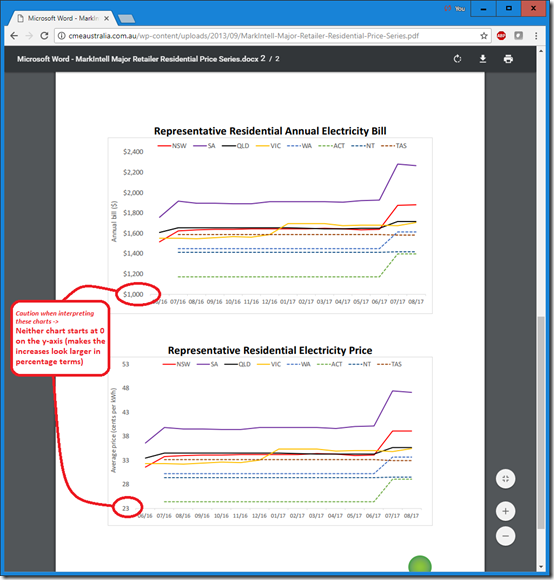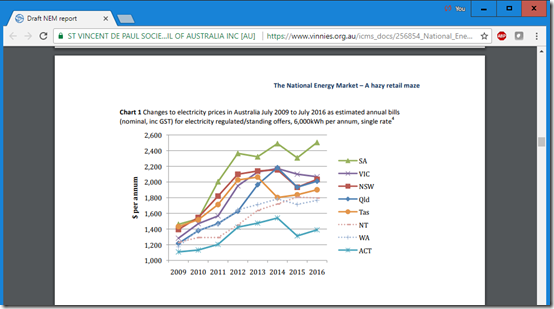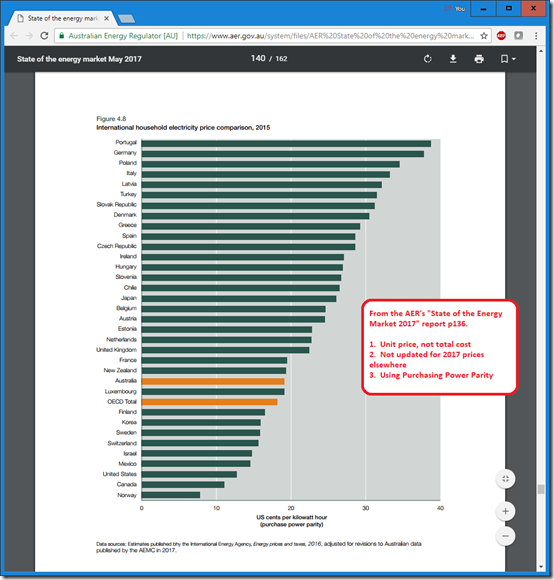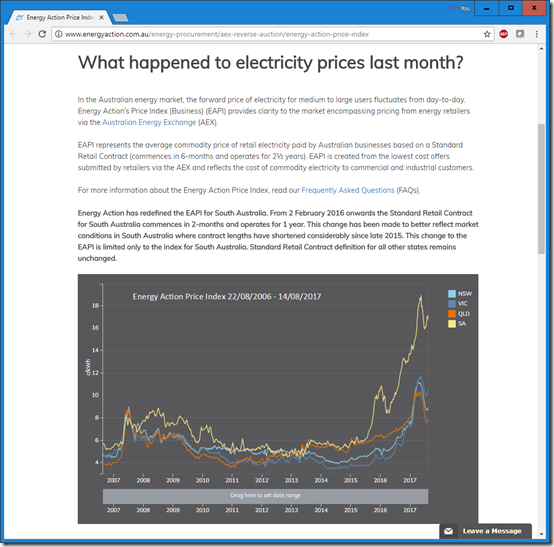As the CEC’s Clean Energy Summit on Wednesday 19th July, I provided this forecast (of sorts) for Australia’s National Electricity Market – talking about the train wreck that’s unfolding before all of our eyes. In my next-day brief article, I undertook to post progressively more of this presentation with some added detail I’d not had time to talk through in the brief presentation. In the four weeks since that time, we’ve been heavily committed to directly assisting clients (both pre-existing, and new ones emerging from the woodwork) through our growing suite of software offerings. Hence no time to post more, at this point.
Last week we were in Adelaide for a few days, including starting some new clients with our software and delivering day-long training session on some detailed nuances of how the NEM operates (in conjunction with one of the external consultants we collaborate with for these types of things).
1) Energy users as “Victims”
Whilst we were in Adelaide, I could not help but notice (given the keen media interest) that a number of CEOs of (the larger) Electricity Retail companies were called to Canberra for our PM’s own version of a “shirt-fronting” on how electricity consumers are being screwed with ultimatums given about vaguely-worded drastic actions that the Federal Government might take if a plan for improvement was not forthcoming (and quick). I believe these same CEOs are back in Canberra today for Act 2, so we’ll see what eventuates out of this…
My forecast at the Conference took the form of a 4-character pantomime, and I invested some time to talk through each of the 4 characters – to examine how they had come to claim these roles (in my view).
I used this image of the “hapless victim” being tied up on the tracks, with the coal-belching steam train relentlessly approaching. This image does seem to resonate with much of the commentary in the mainstream media, and in social media.
Certainly there has been plenty of press coverage of electricity prices and their effect on energy users. We’re partly the reason that this has occurred, with the review of Q2 2017 that I posted on 6th July being picked up by a number of different media networks. My article concerned wholesale prices only (and particularly “physical” prices).
Since that time there has seemed to be an increase in the volume of coverage of the massive increase in cost of electricity paid by energy users (of which wholesale is only one component).
2) More focus is on residential – but is a bigger looming crisis with cost of energy for business?
In what I have seen in the traditional news media, and on social media, the majority of coverage does seem to be focusing on costs of electricity to residential energy users. This is understandable, given that residential energy users are a better direct correlation with the voting population – and we all know that the number one thing that scares any politician is an angry voter.
2a) Costs for residential users have been increasing
… and it’s not like residential customers don’t have a reason to be concerned. Two pieces of analytical work that sum up these concerns are:
(a) The “MarkIntell Major Retailer Residential Electricity Price Series”; and
(b) The St Vincent de Paul series of reports, powered by the Alviss Consulting data sets.It’s my understanding that both sets of analysis are based on the same underlying data – being retailer’s published residential retail offers (though with different methodologies for collection). The MarkIntell series is included here, for your ease of reference:
With the one above, it’s a pity that the data series does not project back further in the past (as that would have delivered a fuller picture of how cost of energy has increased over the longer term). The chart in the Vinnies report (published earlier) below provides that longer-term picture (one that’s primarily about cost increases over the 7 years shown):
It was the MarkIntell update following rate changes for the June->July 2017 transition that led to mainstream media reports of Australian residential energy users paying the “highest electricity price in the world” (including this article in the AFR on 4th August).
However it is worth remembering Keith Orchison’s note of caution published the next day about such inadvertent hyperbole. Here’s the chart from the AER’s “State of the Energy Market 2017” report, as a comparison to the “highest electricity price in the world” comparison:
No matter that what we’re paying in Australia may not be exactly “highest in the world” – the fact that they are high, and increasing, is a very valid cause for concern.
2b) … but my concern is greater for business use of electricity
I am also concerned, however, that a disproportionately low share of the conversation/focus seems to be directed towards the effect these high prices is having on all businesses, and in particular the comparatively large share of energy-intensive energy users Australia has accumulated over past decades.
I posted at the end of June about one South Australian energy user had entered liquidation – at the loss of about 30 jobs, I believe. This energy user had been a very new client of ours, so their name popped out of the liquidation notice when I’d read it (unfortunately what we could do to help was “too little, too late”) – but there are a number of other notices we have seen. There have been a smattering of articles (like Chris Stott’s article in the AFR on 15th August that cautions share investors that energy prices are going to make a significant dent in the bottom line of many companies, which was followed by Michael Bleby’s article on 17th August quoting Stockland in warning electricity prices will flow through to business results)
For a start, it has seemed to me another example of low energy literacy, more broadly, is skewing the focus of discussions around this broad energy transition. Over the past decade and more, too many changes have been marketed in terms of how this-or-that “will only add $X (or Y%) to the average annual residential retail bill”. Yes, residential energy use (and the cost of it) is important – however across the NEM it’s business use of electricity that dwarfs residential use by volume – as noted today in this linked article that I have posted separately, as I have a hunch I’ll need to be referring to it repeatedly in the coming weeks and months.
It’s businesses that provide us our jobs (and salaries), and our dividends from investments. It’s the major energy users that are facing systemic crisis in an environment of escalating cost pressures (in an environment where many seem oblivious to this – and some would even seem supportive of the idea that they shut up and leave, given the mistaken belief that the primary KPI should be “% of supply from [INSERT.HOBBY.HORSE.HERE]”).
Unfortunately, it’s been harder for the market to evolve similar price/cost comparison services such as the two highlighted above for retail electricity prices/costs. There are a number of reasons for this, with three big ones being:
1) The non-standard nature of business electricity consumption (there is no such thing as a “typical” business user – whereas one might grit teeth and believe that a “typical” residential user still exists);
2) Cost offered for business users varies depending on duration of retail contract; and
3) Offers made to business users areOne that I am aware about is Energy Action’s Price Index (EAPI) for business – which has seen a marked upward trend in all four mainland regions in the past year or two – most markedly in South Australia. Here’s the trend that I see today:
If any of our readers know of other (business-focused) price indexes, we’re very keen to hear about them (given that we’re a company full of “data junkies”). Please let us know through comments below, or offline directly (tel +61 7 3368 4064).
3) Energy users are not, so much, “hapless victims”?
With respect to both residential and business users, I did make the comment several weeks ago that the image (above) of the “damsel in distress” might be taken to imply too much helplessness on the part of the energy user.
Certainly there are a number of factors outside of the energy user’s control that have contributed to driving energy costs higher. However there have also been some actions (not taken) within energy user’s control that have added to the inflation of electricity prices. We’ve seen other mainstream media articles point out the “laziness tax” of not shopping around for a better deal that’s affected residential energy users. At the business end, most have been forced to shop around, though the level of sophistication taken in the approach adopted (either by the energy user themselves, or on their behalf by the diverse bunch of retail energy brokers that service them) has shown a wide diversity, from what I have seen.
Other approaches that might offer some benefit (such as spot-exposure and demand response) have been genuinely assessed as options by a growing number of energy users over the past decade, though off a very low base. More recently, self-supplies through embedded generation (primarily PV) has increased in popularity.
Perhaps (with time permitting) we’d be able to showcase some options for business energy users here on WattClarity, with the assistance of the consultants and service providers who supply these services?







Metro7 comment on 1/8/17 deserves repeating………
“It is unconscionable that the world should be turned inside out like this…but for Australia itself the potential for existential damage is of a magnitude that dwarfs that for all the other first world countries …because we have no alternatives after the Left kills fossil fuel.
Every other first world country has base load alternatives such as massive hydro and or nuclear and connectors to other countries to fall back on in the case of energy insecurity…Australia has none of that!
Australia will be ALONE…out on a dangerous limb as this RE juggernaut demands it commits suicide….the only country in the world being told to commit economic and social suicide !”
Paul
Thanks for the post – it started me thinking and developing some thoughts I already had. The argument is that the current high wholesale price for electricity is being driven by wind (see above post) and gas.
But where is the benefit of the lower cost coal and wind reflected in the wholesale prices? Using NEMReview v6 I drew up a chart on a quarterly basis of the last 4 years of the total contributions of black and brown coal, hydro, wind and gas and matched these to the total NEM demand. (I tried to paste this into the dialogue box but it won’t paste!)
Interestingly the share of wind and coal to the total consumption have barely changed, ranging from 77 to 84% and the last quarter being 81%. The contribution from wind has also been a fairly constant proportion too ranging form 3% to 5%.
The cost of coal fired electricity has not moved much over the past 4 years but the cost of electricity has doubled. While I agree that the cost of gas fired electricity has increased, the volume of the gas generation hasn’t risen by much but the futures prices for electricity now seem to be based on the current high cost of gas as is the spot price.
So where has the benefit of the low cost coal and wind fired generation gone? The 2017 annual reports from Origin and AGL both show significant increases in contributions from their electricity sectors over the past 12 months.
So maybe he NEM rules need to be reviewed because they may be the cause that has allowed the gentailers to gain significant benefits.
David
I don’t know if Paul answered your query separately, but let me have a go if he hasn’t.
As you no doubt know, the wholesale market price is set each half hour at a price which draws on enough supply to satisfy the demand over that half hour (“the market clearing price”). AEMO calls the cheapest sources first and then goes up the cost curve until it has enough supply to match demand. The last generator on that finally satisfies demand sets the market clearing price.
As coal plants close (eg Hazelwood), gas fired generators are increasingly becoming the generator that is last on and sets the market clearing price. A number of moth-balled gas fired plants are being restarted in response to the changing supply situation and the higher prices provide sufficient price incentive to do so.
So as gas prices have risen, so has the price that gas fired generators require to turn on and respond to market demand. This is what is driving up the wholesale price – the rising price of gas. (There may also be some pricing uncertainty as well due to the insecure nature of supplies as coal exits the market and there is no resolution on a national emissions policy).
The coal fired generators and renewables (when they supply) are probably doing very well as their costs are not changing but the price they are receiving from the market is much higher than it has been over the last 4-5 years.
Addressing the gas situation (and landing a national emissions policy) would go a long way to addressing the trend in electricity wholesale pricing without having to tamper with the NEM rules, which in itself creates uncertainty.